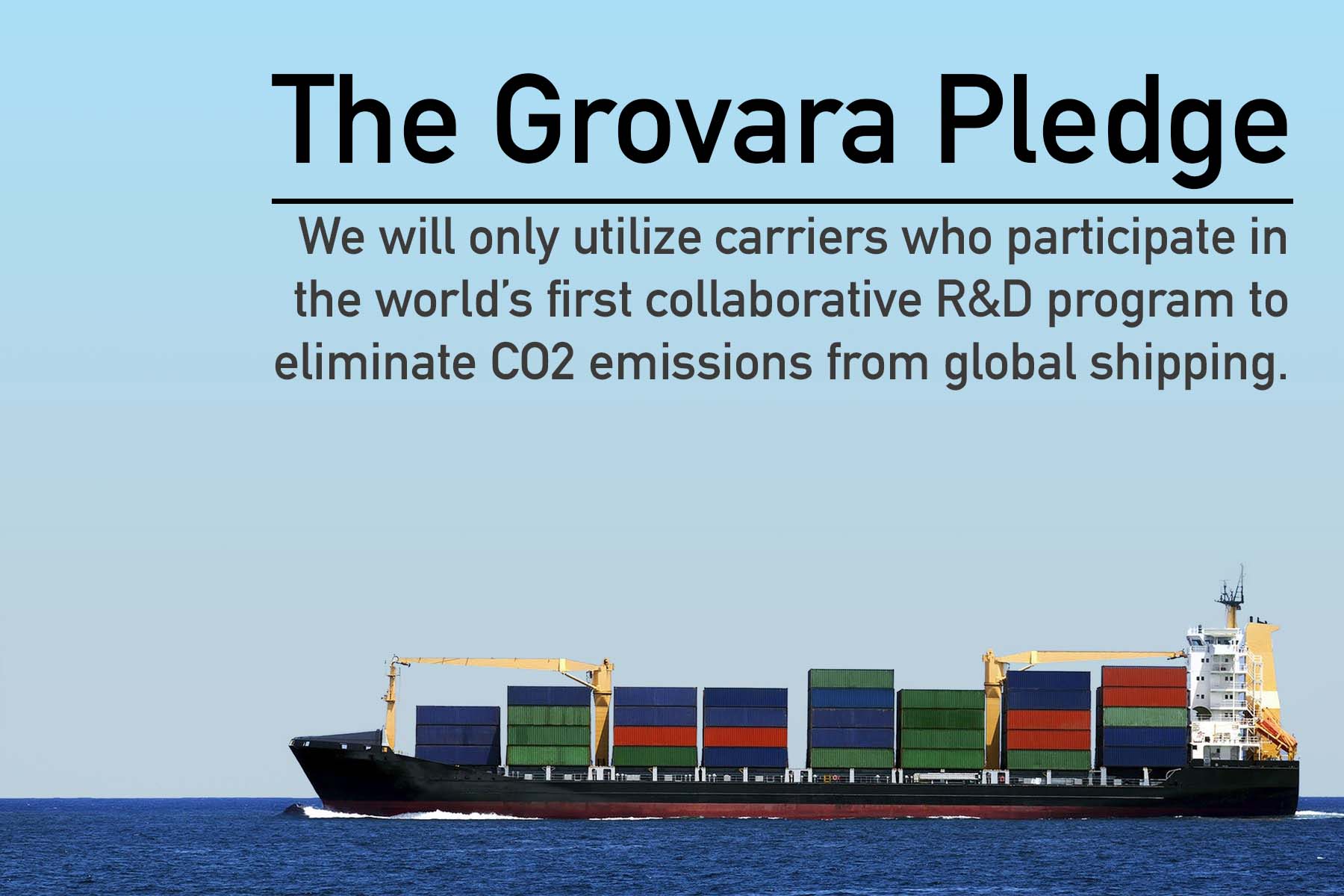Grovara Pledges to Only Use Carriers Supporting $5 Billion, Industry-Led Effort to Eliminate CO2 Emissions From Global Shipping
It has been two years since the United Nations’ International Maritime Organization (IMO) agreed to a 50% minimum reduction of total greenhouse gases from international shipping, which is responsible for 2% of the planet’s anthropogenic CO2 emissions, a figure expected to rise to 17% by 2050 if unregulated.
It is only recently, however, that concrete measures have been taken toward that 50% reduction, and it comes in the form of $5 billion over 10 years from eight of the world’s largest trade organizations to fund a crash program, announced on Dec. 31, that will eliminate C02 emissions from global shipping.
Philadelphia technology company Grovara, the leading exporter of American wellness products, is rolling out an initiative to only utilize carriers who participate in this important program, which will form a new non-governmental Research & Development organization to accelerate development of commercially viable zero-carbon emission ships, paving the way for decarbonization of shipping.
“Grovara will continue to maximize the ROI of our total supply chain for everyone, including our biggest partner — Mother Earth,” says Grovara co-founder and CEO Peter Groverman.
The program, which proposes the establishment of an International Maritime Research and Development Board (IMRB) and will be funded by a mandatory R&D contribution of $2/per ton of marine fuel purchases, was formed by BIMCO (largest shipowners organization), International Chamber of Shipping (owners and operators from all sectors, trades), World Shipping Council (container liner industry), Cruise Lines International Association, Interferry (ferry industry and suppliers), Intercargo (dry bulk carriers), Intertanko (tanker operators) and the International Parcel Tankers Association.
In the book of climate change, international trade is a vital chapter. Currently 90% of global trade depends on shipping, and the UN Conference on Trade & Development anticipates international trade will continue to grow — the UN’s IMO predicts C02 emissions from global shipping could increase by up to 250% by mid-21st century. Maritime shipping is the backbone of international trade, but it’s also something of an invisible industry, literally and figuratively.
The C02 emissions from international shipping — often unnoticed because these humungous carriers float along far away on the high seas or in far-flung, hard-to-traverse corners of the world — are about equal to the fifth-largest emitting country. But because the emissions are generated from international shipping they don’t belong to one nation — they belong to everyone AND belong to no one — and are subsequently not covered by the 2015 Paris Agreement, the UN’s landmark global framework to combat climate change. That’s why the IMO established the 50% reduction benchmark in 2018. The $5 billion proposal cites the development, scaling, and application of new technologies as “probably the most important steps” is hitting the IMO benchmark, and that responsibility for decarbonization of the sector is “not the sole responsibility of shipping companies and must ultimately be driven by a broad set of stakeholders.”
Grovara works with numerous third-party logistics providers across the globe to chaperone the American wellness manufacturers it represents, from their U.S. production facilities to overseas retail shelves, streamlining and automating shipping, registrations, customs clearances, and last-mile fulfilment.
“As part of the global trade ecosystem, Grovara recognizes the urgency and importance of sustainable solutions,” says Grovara Director of Operations and Supply Chain Juliana Rogenski. “We are looking forward to support organizations that are part of the program.”
The consortium of eight industry leaders expect to put into place an IMRB that will govern the R&D program and its funding by 2023, via amendments to the existing IMO Convention for the Prevention of Pollution from Ships (MARPOL).
Here’s a closer look at the organizations driving the $5 billion program:
BIMCO: The largest international shipping association is made up of shipowners, operators, brokers and agents and is out front of global developments in shipping. More on its environmental news here.
Cruise Lines International Association: World’s largest cruise line industry association with 95% representation of global cruise capacity, includes 15,000 global travel agency and 25,000 travel agent members. View the group’s sustainability initiatives here.
Intercargo: Representing dry cargo shipowners, particularly when it comes to safety, environment and operations. More on its emissions program can be found here.
Interferry: Representing 40 countries and all sizes and types of ferry operations, this group focuses on regulatory, safety and advocacy issues. Check out the association’s regulatory work here.
International Chamber of Shipping: The principal international trade association for merchant shipowners and operators, representing all sectors and trades and over 80% of the world merchant fleet. Read more on its CO2 reduction approach here.
International Parcel Tankers Association: Since 1987 the IPTA has provided a pathway for regulators and tanker owners and operators to improve the industry, and maintains consultative status with the IMO. Read more about its environmental work on its news page here.
Intertanko: Promotes “Zero fatalities, Zero pollution, Zero detentions” among its members, while leading workplans and establishing benchmarks for safety, the environment and commercial sustainability. More on its “Emissions to air” overview and guidelines here.
World Shipping Council: Members operate approximately 90% of the global liner ship capacity, providing about 400 regularly scheduled services linking the world’s continents. Collectively, these services transport roughly 60% of global seaborne trade and more than $4 trillion in goods annually. More on its environmental stewardship here.
